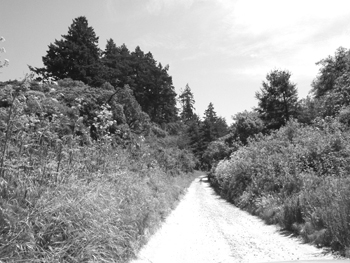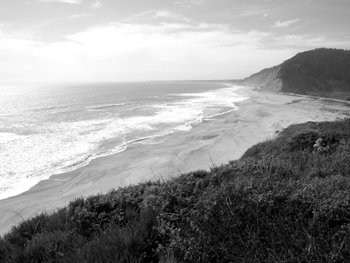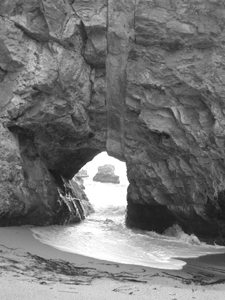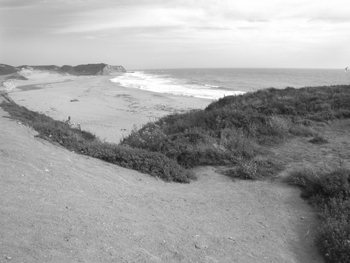![[Metroactive News&Issues]](/gifs/news468.gif)
[ Santa Cruz | Metroactive Home | Archives ]
North Edgy
It was a hard-won, costly battle to preserve the Coast Dairies property a few years ago. Now, the federal government is coming in to help manage the 7,500 undeveloped acres north of Santa Cruz. Some say the land is well-protected, but others worry about loopholes in the terms of preservation and the idea of entrusting the Bush administration with some of Santa Cruz County's most beautiful open space.
By Rebecca Patt
The $43 million rescue five years ago of the magnificent Coast Dairies property surrounding the town of Davenport was a celebrated victory for environmental activists locally, and rightfully so. After all, the preservation of 7,500 acres of prime undeveloped Santa Cruz coastline that looked at times like it might be paved over into a subdivision or a nuclear power plant seems like an unqualified win for the conservationist cause.
But this pastoral paradise may be facing yet another threat, as control of most of Coast Dairies is about to be transferred to the Bureau of Land Management, a huge government agency that currently has a terrible environmental record and questionable resources for managing the land effectively.
Although the BLM is the largest landholder in the United States, and several counties in the western United States are comprised almost entirely of BLM lands, the only property the agency currently manages in Santa Cruz County is the rocks right off the beach--President Clinton entrusted them to the BLM, along with the other 12,000 rocks up and down California's coast, in 2000.
BLM properties are designated for many uses: mining, timber, grazing, drilling, habitat preservation, and recreation, including the wild celebration that attracts 25,000 people every August to the middle of the BLM-owned Nevada desert. Which makes one wonder: could the agency that makes space for Burning Man really be all that bad? What do these new neighbors plan on doing with Coast Dairies? Will the worst fears of concerned locals be realized? Are we going to see George W. Bush off-roading on our delicate coastal grasslands?
Probably not, but these days, you never know. The Bush administration has been aggressively pursuing mining and drilling and supporting a host of Dubya-ious environmental policies that allow for things like 26,000 miles of new roads and 20,000 miles of new methane pipelines in the Powder River Basin of northeastern Wyoming.
The current owner of the Powder River Basin? The Bureau of Land Management.
With Coast Dairies, the BLM and the California Department of Parks and Recreation will be gaining control of a jewel of open space on the California coast that has been a focus of preservation efforts for decades. The property encompasses six major beaches, over five miles of coastline, seven wetlands, 760 acres of farmlands and 700 acres of forest. It extends into the rugged hills about two miles inland where deer, bobcats and coyotes roam. The land features unique habitats that are home to endangered species including steelhead and coho salmon, snowy plover and red-legged frog. It has six creeks running through it, including San Vicente Creek, the southern-most stream in the United States to support coho salmon and the primary coho habitat south of the Bay Area. Only two public roads cross the property, Highway 1 and Bonny Doon Road.
Except for the RMC Lonestar cement plant and a few leased artichoke and brussels sprout fields and grazing cows, the land looks essentially the same as it did during the 19th century.
"People from Southern California say they think that their coast used to look like this," says Davenport resident Marilyn Fravel, whose grandfather immigrated to Davenport from Italy in the early 1900s to work in the cement plant.
Up until a few years ago, the land was owned by two Swiss immigrant families, who purchased the property in 1902 from Spanish land grants. When the dairy business dried up along the coast by the 1920s, they moved back to Switzerland and continued to lease the land the tenant farmers and dairy operators.
County officials have been working to preserve the land since the 1960s, when Pacific Gas and Electric proposed building a nuclear power plant at the site. After several attempts over the years to permanently protect the property, a national nonprofit land conservation organization, the Trust for Public Land (TPL), acquired Coast Dairies for $43 million in 1998, saving it from a Las Vegas developer who wanted to subdivide it into 139 homes. About half of the funding came from the Packard Foundation, and the state of California contributed an additional $5 million.
TPL's intention was to rescue the land from impending development and facilitate its transition into the care of a government agency or community land trust wherein it could be permanently protected--in this case, the BLM and State Parks are going to share the responsibility. State Parks will manage the 400 acres on the beach side of Highway 1, with the BLM handling the bulk of the land on the inland side.
TPL has been drafting a document that is to serve as a template for the BLM's and State Parks' short- and long-term management of the property. This plan was originally expected to take one year to complete, but due to bureaucratic complexities, it has taken five years. Now TPL is set to officially transfer the land to the BLM and State Parks in September.
An essential part of the Coast Dairies management plan is the deed restrictions TPL has secured on the property. The restrictions state that logging and off-road vehicle use will be prohibited, that agriculture will continue on the land to the maximum extent possible, that sensitive habitats and species will be protected and that recreation opportunities will be maximized so long as they are in sync with those other priorities. TPL will retain the mineral rights to the property outside of the cement plant's current lease area.
One glitch is that neither TPL nor either of the agencies has yet conducted an environmental impact review (EIR) on Coast Dairies. An EIR is the all-important glue that will make the long-term management plan a legally binding document.
"When TPL first acquired the land, they said it was their intention to do an EIR and complete the master plan before turning it over. That would have given the community more assurance, but unfortunately that's not what happened," says county supervisor Mardi Wormhoudt, a longtime watchdog for the preservation of North Coast lands. "As it is, if the property is transferred without the EIR, the TPL plan will only become one of the plans that will be considered."
Wormhoudt says that in the current absence of an EIR, she is trying to broker a special agreement between TPL and the county that TPL will not transfer the land unless the agencies agree to the deed restrictions.
"Deed restrictions are an absolute way to protect the land, but we all need the surety of knowing that the federal government will agree to these restrictions. So far all we have is the agreement of regional directors, and apparently there is an agreement at the state, but we've seen nothing in writing that the federal government will agree to these terms," says Wormhoudt. "The Bush administration has not been the most sensitive administration for environmental protections."
Yet even with the BLM accepting the deed restrictions, some folks are worried about the capacity of the federal government to muck up Coast Dairies' natural splendor.
"If the current administration is not respecting the United Nations and various treaties, what's to stop them from disrespecting the deed restrictions if they say it's in the interest of national security?" says Jodi Frediani, forestry task force chair of the local chapter of the Sierra Club.
Rick Hanks, BLM liaison for Coast Dairies and California Coastal National Monument manager, insists that the BLM does not intend to break the deed restrictions--nor, by the way, are they moving Burning Man there.
"We're not that scary," he says. ""We're interested in managing it for the long term, for the unique environmental systems that are there. We're not looking at doing a whole lot for a number of years, just maintaining it and providing some kind of controlled access. BLM and State Parks' No. 1 goal is going to be to keep the property as is and keep it from getting trashed."
Another concern is whether these cash-strapped and understaffed agencies will have the money and personnel to manage the land and handle safety and public access issues.
Both agencies are being asked to handle increasing responsibilities with the same or less funding. State Parks especially has been hard hit. The regional State Parks office is already operating with half a million less dollars than in 2002 and is being asked to cut another half-million from its Santa Cruz operations. Besides recovering from having their office firebombed on April 1, they're looking at moving their headquarters from Ocean Street to Henry Cowell Redwoods State Park where their office rent expense would be eliminated. And due to restructuring, the office is picking up responsibility for all the State Parks units along the coast in San Mateo County.
With all these factors, "I can't tell you when we are going to get around to doing a general plan [the document that requires the EIR]. That's going to cost some time and some money. For the short-term and foreseeable future, the thing that folks want to concentrate on is what's going to be allowed in the interim-use plan," says Dave Vincent, district superintendent of the California Department of Parks and Recreation.
Vincent estimates that the interim use plan is going to take at least six more months to complete.
"It's going to take a bit of time before we can allow public access to the property, even though it comes under public ownership," he says. "We are going to do our best to resolve environmental issues, allow access and meet the concerns of neighbors to the park."
The land currently has few trails on it, and Vincent says officials will be determining the viability for more trails, including a coastal trail that connects all the beaches, similar to the one at Wilder Ranch.
With the eventual increased public use, Davenport residents are worried how the agencies will provide law enforcement and emergency services to the area.
"We don't even have a sheriff for the North Coast," says Fravel. "The sheriff here is from the Live Oak office."
Hanks said he anticipates that the agencies will probably hire somebody at least part-time to serve as law enforcement, and that they will hire a full-time project manager.
He cites the similarities of Coast Dairies to Fort Ord in Monterey, where the BLM has taken over management of 7,000 acres of the coastal former military base. The BLM's presence at Fort Ord is generally considered to be a success for public access and the preservation of the environment. A large volunteer group there called BETA (Bike and Equestrian Trails Assistance) has been very effective at helping take care of the land where BLM staffing falls short.
For years, the farmers had been irrigating their crops in the summer with water from the streams, causing them to run very low. This was fine until coho and steelhead were listed as endangered species. When the state Department of Fish and Game found out what was happening, they threatened TPL with major lawsuits. The farmers had to stop using the water.
Jim Cochran, owner of Swanton Berry Farm, has had to cut back his production of organic strawberries on leased Coast Dairies property from 29 acres to three acres.
"I'm adjusting my production plans accordingly, and it won't put us out of business, but it'll just make it a little more difficult," says Cochran. "But for the long term, it's definitely important to have water there. It'll help preserve jobs."
Wormhoudt has convened a large working group to figure out how to secure water rights in the county's name and execute an expensive plan to build off-season water storage tanks to gather excess water in the winter and save it for use during the summer.
"I think we have an opportunity to create a model for good environmental protection and allow the continuation of traditional agriculture on the property," says Wormhoudt.
In spite of the many details to be worked out, Wormhoudt urges people to remember to appreciate the progress that has been made in saving Coast Dairies as open space.
"The preservation of this land is an absolutely amazing and wonderful gift not only to people in Santa Cruz but to people everywhere for generations to come," she says. "People are absolutely correct to be concerned about proper and ongoing stewardship, but in terms of our struggling for the best agreement I don't want us to lose sight of what an amazing gift this is."
Why locals are worried about putting Coast Dairies land into Bush's hands
By Rebecca Patt
Considering the environmental record of the Bush administration, it's no shocker that people are concerned about the fate of Coast Dairies-and this nation's air, water, forests, and wildlife in general.
Since George W. took office in November 2000, environmental protection policies of every kind have been steadily eliminated, rolled back, ignored or threatened. In the name of promoting corporate and industry interests, Bush and Co. have undone much of the environmental progress that was made during the Clinton era. And with attentions focused on the Middle East, much of it has barely registered on the public radar screen.
Leading the environmental assault under Bush is Secretary of the Interior Gale Norton, the former attorney general of Colorado. Norton holds the top position for overseeing major environmental laws and managing America's 500 million acres of public lands, including the BLM. She has distinguished herself by championing an environmentally-destructive agenda and appointing a long list of former timber, mining, and oil industry lobbyists and executives (and not a single environmental advocate) to key Interior Department positions.
For example, Norton's top deputy is J. Steven Griles, former lobbyist for Occidental Petroleum and the National Mining Association. Her special adviser on the unsuccessful plan to open the Arctic National Wildlife Refuge to oil drilling (the Senate voted it down in March) was Camden Toohey, director of the pro-oil development group Arctic Power, which exists solely to promote drilling in the refuge.
Mark Rutzick, who for years has been the lead attorney for the timber industry in countless lawsuits seeking to reopen the Pacific Northwest forests to logging, was named as senior adviser to the National Oceanic and Atmospheric Administration--in other words, he's Bush's point man for legal issues and tactics involving salmon. And former timber industry lobbyist Mark Rey was appointed to oversee the U.S. Forest Service as undersecretary for natural resources at the Department of Agriculture.
Here's a quick run-down on some of the biggest environmental policy changes the Bush administration has enacted or proposed:
· In April, the Interior Department and the State of Utah struck a deal in which Norton committed to prohibit the BLM from designating any more Wilderness Study Areas, not just in Utah but in all western states. Norton also ordered the BLM to halt wilderness reviews in Alaska and to consider wilderness only the places that are broadly supported by Alaskan elected officials.
· By refusing to defend itself in industry lawsuits, the Bush Administration has all but abandoned the National Forest Roadless Area Conservation Rule, a Clinton-era measure that preserved nearly 60 million acres of roadless areas in national forests.
· Bush is pushing the Healthy Forests Initiative, aimed at lessening wildfires by slashing environmental review requirements and public participation on logging projects of any size intended to reduce forest fires. The initiative would repeal large parts of the National Environmental Policy Act and offer timber companies the right to cut down large trees in exchange for cutting down smaller ones that pose more of a wildfire risk.
· Bush has proposed broad changes to the National Forest Management Act that would remove longstanding requirements for wildlife protection, scientific analysis, and public comment.
· The Interior Department moved in January to open long-abandoned mining trails, cattle paths and wagon roads on federal lands to off-road vehicles. This rule change makes it easier for state and local governments to claim right-of-way on the old paths.
· The Bush administration has dropped a Clinton-era plan to phase-out snowmobiles from Yellowstone Park. In a deal with the snowmobile industry, Norton has proposed bringing more snowmobiles than ever into the park.
· In charge of enforcing the Federal Endangered Species Act, Norton has removed or ignored several wildlife protections. She is planning on removing gray wolves from the endangered list, just as they are starting to make a comeback, and she overturned an approved plan to restore the endangered grizzly bear to the Bitterroot Mountains. She has neglected to enforce a landmark ruling designating new sanctuaries for Florida manatees, resulting in a record number of their deaths. She also contributed to the deaths of 30,000 endangered salmon--the worst fish-kill ever on California's Klamath River--by agreeing to divert water for irrigation purposes. Meanwhile, the Commerce Department has weakened the requirements for using "dolphin-safe" labeling on tuna fish cans.
· In March 2001, Bush withdrew the U.S. from the Kyoto Protocol, which most of the nations of the world signed in 1997 to agree to reduce carbon dioxide emissions in the hope of reducing global warming. "It is not in the United States' economic best interest...I will not hurt our workers," he said. The U.S. is by far the world's heaviest polluter of carbon dioxide.
[ Santa Cruz | Metroactive Central | Archives ]
Copyright © Metro Publishing Inc. Maintained by Boulevards New Media.
![]()

Photographs of Coast Dairies property by Stephen Laufer

Jewel of the Coast

Protection That Lasts?

Overworked and Underfunded

Meanwhile, Wormhoudt has taken the lead on working out another problem at Coast Dairies that is not likely to be resolved for several years: how farmers and the endangered salmon can share the water supply.
The Texas Chainsaw Massacre
From the June 4-11, 2003 issue of Metro Santa Cruz.